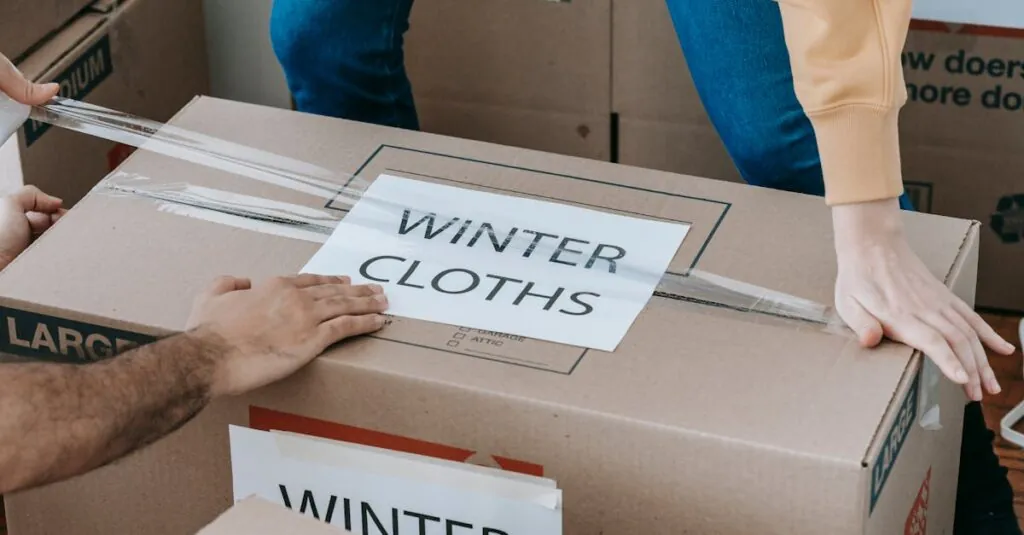Table of Contents
ToggleMoving can feel like a circus act—juggling boxes, dodging furniture, and somehow managing to keep your sanity. Before diving headfirst into the chaos, it’s crucial to declutter your space. Imagine packing up all those mystery items from the back of your closet. Spoiler alert: that 10-year-old pizza cutter isn’t making the cut.
Understanding the Importance of Decluttering
Decluttering before moving significantly eases the entire process. It reduces the volume of items that need packing, ultimately saving time and effort. Over time, belongings accumulate, leading to clutter that can create stress during a move. Focusing on which items to keep ensures only essentials make the journey to the new space.
Many people find it beneficial to assess each item’s utility. Questions like “When did I last use this?” support informed decisions. Donating or discarding items that hold no value can also positively impact the community. Recycling outdated items contributes to sustainability efforts.
Photographs or sentimental items often present challenges during decluttering. These objects evoke emotions and memories. Setting limits on the number of keepsakes encourages thoughtful selections, ensuring a manageable collection for the new home.
An organized space promotes clarity and comfort in the new environment. When moving into a clutter-free space, individuals can focus on adjusting to their new surroundings. It allows for a fresh start, supporting mental well-being and fostering productivity.
Planning a decluttering timeline helps in managing the process effectively. Establishing mini-goals, like decluttering one room per day, simplifies the workload. Designating specific times to tackle each area avoids overwhelming feelings and reinforces progress.
Before packing, ensure that every item has a purpose in the new home. This preparation facilitates smoother packing and creates a streamlined moving experience. Recognizing the importance of decluttering significantly impacts the overall moving strategy, leading to a more enjoyable transition.
Creating Your Declutter Before Moving Checklist
Creating a decluttering checklist simplifies the moving process. By following structured steps, individuals can minimize stress and prepare for their new homes.
Categorize Your Items
Categorizing items proves essential during decluttering. Start by grouping belongings into categories like keep, donate, sell, and discard. Clothing, furniture, and kitchenware represent common categories people encounter. Labeling boxes can help ensure each category remains organized throughout the move. Prioritize high-traffic areas, such as living rooms and kitchens, before tackling bedrooms or storage spaces. This allows for gradual progress. As they sort, individuals should evaluate the usefulness of each item, asking questions like when it was last used. Decisions become easier when items are assessed in organized groups.
Set Timelines for Decluttering
Setting timelines for decluttering fosters consistency and keeps individuals on track. Designate a specific timeframe for each category or room, striving for achievable goals. For instance, allot one weekend for bedrooms and another for the kitchen. Breaking down the decluttering tasks into manageable segments prevents feelings of overwhelm. Assigning specific days for donating or selling items can create urgency, motivating individuals to complete their decluttering checklist. Creating a countdown to moving day serves as a reminder to stay focused. Flexible timelines accommodate unforeseen challenges, ensuring that individuals can adapt their plans without stress.
Tips for Effective Decluttering
Decluttering simplifies the moving process. Focus on practical strategies for efficient organization.
Keep, Donate, or Discard
Assess each item by asking key questions. Determine if it adds value to your life or if it can be donated or discarded. Identify belongings that haven’t been used in over a year. Items that linger unused could either be donated, sold, or thrown away. Prioritize quality over quantity when deciding what to keep. Establish a limit for sentimental items, which helps maintain a manageable collection. A thoughtful approach minimizes stress and aids in creating a clearer living space.
Utilize the Four-Box Method
Employing the four-box method enhances organization. Label boxes as Keep, Donate, Sell, and Trash. Start sorting items methodically into each box. Keeping an item means it remains useful or cherished. Donating or selling items allows for giving back or earning some money. Trash those items that serve no purpose. This visual approach streamlines the decision-making process and prevents indecision. Engage in this method for each room to maintain focus and clarity.
Preparing for the Move
Effective preparation for a move includes organizing the decluttering process. Implementing structured steps eases the transition and creates a clearer path forward.
Packing Efficiently
Packing starts with gathering necessary materials like boxes, tape, and markers. Labeling boxes by room aids in identifying contents later. Establishing categories, such as keep, donate, sell, and trash, is essential. Focus on high-traffic areas first, such as living rooms and kitchens. Prioritizing items based on usage reduces packing time. Aim to pack non-essential items earlier to minimize last-minute chaos. Using the four-box method keeps the process organized and straightforward. Adhering to a timeline helps maintain momentum leading to moving day.
Organizing Your New Space
Organizing the new space begins with a clear plan. Arranging furniture and belongings should reflect functionality and comfort. Start by placing larger items first, then fill in with smaller decorations. Designate specific spots for essential items, promoting easy access. Assess the layout for optimal flow and natural light. Utilizing storage solutions, such as bins and shelves, maximizes space effectively. Personal touches can enhance the ambiance while maintaining organization. By planning the setup of each room, individuals foster a welcoming and efficient home environment.
Decluttering before a move is more than just a practical step; it’s a transformative process that sets the stage for a fresh start. By thoughtfully assessing belongings and making intentional choices about what to keep, donate, or discard, individuals can significantly lighten their load. This not only streamlines packing but also fosters a sense of clarity and ease during the transition.
Implementing a structured decluttering checklist helps maintain focus and organization throughout the process. It encourages individuals to approach each room methodically, ensuring that moving day is less chaotic and more manageable. Ultimately, embracing the decluttering journey paves the way for a new living space that feels welcoming and reflects personal values.




